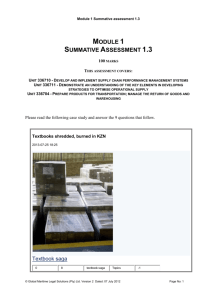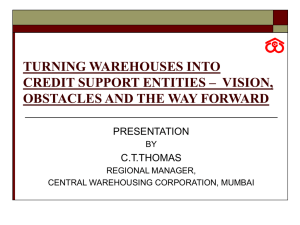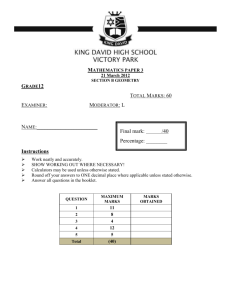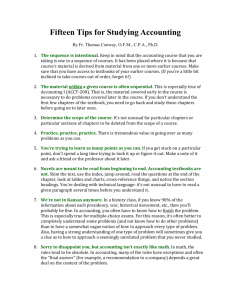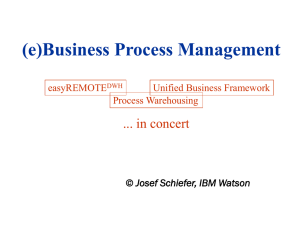Module 1
advertisement
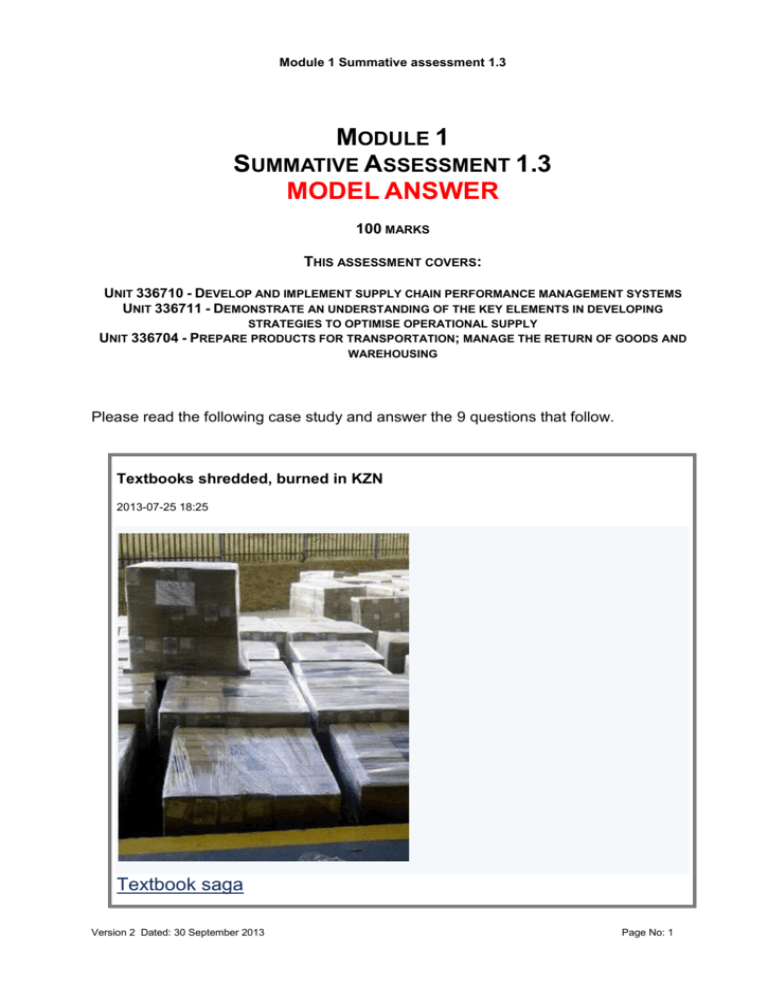
Module 1 Summative assessment 1.3 MODULE 1 SUMMATIVE ASSESSMENT 1.3 MODEL ANSWER 100 MARKS THIS ASSESSMENT COVERS: UNIT 336710 - DEVELOP AND IMPLEMENT SUPPLY CHAIN PERFORMANCE MANAGEMENT SYSTEMS UNIT 336711 - DEMONSTRATE AN UNDERSTANDING OF THE KEY ELEMENTS IN DEVELOPING STRATEGIES TO OPTIMISE OPERATIONAL SUPPLY UNIT 336704 - PREPARE PRODUCTS FOR TRANSPORTATION; MANAGE THE RETURN OF GOODS AND WAREHOUSING Please read the following case study and answer the 9 questions that follow. Textbooks shredded, burned in KZN 2013-07-25 18:25 Textbook saga Version 2 Dated: 30 September 2013 Page No: 1 Module 1 Summative assessment 1.3 0 8 textbook saga Topics -1 Durban - Textbooks meant for schools in KwaZulu-Natal were found shredded and burnt at a warehouse in Empangeni, provincial education authorities said on Thursday. They were to have been delivered to schools in the province by March, education MEC Senzo Mchunu said. The books were discovered on Wednesday at a warehouse belonging to UTi Distributors, a company the basic education department had contracted to distribute textbooks in all provinces. "We can't help but suspect that there is a case of huge corruption on the part of the company in question," Mchunu said. UTi Distributors denied not delivering textbooks to schools in the province. The company's Africa divisions director Greg Saffy said in a statement about 100 school workbooks from the 2012 school year were found irreparably damaged and shredded at its Empangeni warehouse. He said no schools had been adversely affected and there was no evidence of "criminality" or "corruption". Mchunu said the department began suspecting something was amiss when, instead of distributing workbooks directly to schools, UTi decided to deliver workbooks to the offices of the Uthungulu district. "That meant we had to incur unnecessary expenses where principals had to drive to the district offices to collect workbooks. This inefficiency happened more than once." The department investigated and found the textbooks in Empangeni. Mchunu said he had reported the matter to Basic Education Minister Angie Motshekga and police. UTi said once it had identified the schools for which the damaged books were intended, the workbooks were replaced and delivered. The replacement was done within two weeks, and no schools were affected. 5 578 550 workbooks delivered "UTi delivered 5 578 550 workbooks in KwaZulu-Natal in 2012, and have delivered 5 122 660 to the province for the 2013 school year," Saffy said. He said the company was conducting its own investigation. Once that was complete disciplinary steps would be taken if necessary. Saffy said UTi would provide Motshekga, Mchunu and other relevant parties with an official report as soon as possible. "UTi was appointed as a service provider to a Joint Venture (JV) with Paarl Media and Lebone Litho for the distribution of school workbooks," he said. Saffy said the JV agreed with UTi's statement. The African National Congress in the province condemned the non-delivery of textbooks. "It is absurd that books which are of great value to our children could be disposed of in this careless way," ANC spokesperson Senzo Mkhize said in a statement. He said this proved that some business people did not care about the development of the country and pupils. "The ANC in KwaZulu-Natal therefore calls for a speedy police investigation so that the perpetrators of this unspeakable deed are prosecuted and blacklisted from doing business with any government department or public entity." Version 2 Dated: 30 September 2013 Page No: 2 Module 1 Summative assessment 1.3 - SAPA Please answer the following 9 questions: 1. How would you define performance management and what conclusions can you draw regarding the performance management with reference to the incident in this article? (20 marks) 2. How would you develop indicators for a supply chain performance management system with relevance to the supply of textbooks to the schools? (10 marks) 3. How would you implement a supply chain performance management system relevant to the supply of textbooks to schools? (10 marks) 4. How would you analyse the influence of an organisation's strategy on the performance, supply chain and operational process types relevant to the supply of textbooks to the schools? (10 marks) 5. How would you evaluate the implications of pursuing specific performance objectives with relevance to the supply of textbooks to the schools? (10 marks) 6. How would you assess key aspects influencing market and customer profiling with relevance to the supply of textbooks to the schools? (10 marks) 7. How would you manage warehousing with relevance to the supply of textbooks to the schools? (10 marks) 8. How would you manage the return of goods with relevance to the supply of textbooks to the schools? (10 marks) 9. How would you prepare products for transportation with relevance to the supply of textbooks to the schools? (10 marks) ********************************************************************************* MODEL ANSWER Answer to be weighted 80/20, where 80 percent is knowledge based and 20% the learner's own interpretation. Q1. The student must define the concept of performance management indicating its relevance and influence on the effectiveness of the supply chain The student must examine the aims and objectives of performance management in line with supply chain management requirements Version 2 Dated: 30 September 2013 Page No: 3 Module 1 Summative assessment 1.3 The student must analyse performance management philosophies and techniques to determine how they influence the process of selecting the most appropriate techniques to suit specific situations The student must evaluate effective measurement to reflect its importance for the development of criteria for measurement systems across the supply chain The student must illustrate the influence of performance management on people and systems Q2. The student must develop correct performance indicators in accordance with the requirements of specific supply chain management scenarios The student must evaluate key indicators to determine their relevance and usefulness in the supply chain performance management system Q3. The student must use information from organisational costing systems to measure the performance of elements of the supply chain (Implement includes but is not limited to application, measuring performance, recommendations for improvement) The student must calculate the productivity of equipment, people, money and processes to ascertain the effectiveness of the supply chain management function The student must identify and use organisational process mechanisms to ensure the effective use of performance data throughout the supply chain The student must analyse the measured performance results to determine appropriate action (analysis include evaluation of benefits and pitfalls of the various improvement approaches, the application of BPR and best practices, Interpreting financial information) The student must analyse performance measurement results to reflect their relationship and impact on different areas of the supply chain The student must use different improvement approaches and techniques reflecting the improvement actions specific to the approach in order to improve the performance of the supply chain Q4. The student must analyse strategic scenarios to determine the positive and negative impact on the supply chain and the performance and operations of the organisation (Operational process types include but are not limited to Project, jobbing, job shop/batching, repetitive, continuous, service professional, service mass, service shops) The student must identify and classify different operational process types classified to determine their influence on the organisational strategy The student must examine operational process types in terms of the rules governing each of the process types The student must justify and motivate the appropriateness of a specific process type for use in terms of their relevance to specific operational and market situations Version 2 Dated: 30 September 2013 Page No: 4 Module 1 Summative assessment 1.3 Q5. The student must identify and evaluate performance objectives to determine their impact on the optimisation of operational supply and analyse how they contribute to the achieving strategic objectives. The student must identify conflicting objectives to determine if corrective measures are required The student must use diagnostic tools to analyse the relationship and interaction of various performance objectives Q6. The student must explain the concept of order winners and order qualifiers to demonstrate their applicability to the organisation (key aspects include but are not limited to concept and implications of order winners and order qualifier objectives, competitive edge/minimum criteria, market segmentation concepts, price leadership, product differentiation and customer focus) The student must examine the application of the concept of order winners and order qualifiers to reflect they are applied in a range of organisations The student must analyse various types of markets to indicate which specific markets will impact on the operations strategy The student must illustrate the utilisation of market segmentation information to reflect its influences on the development of an operations strategy Q7. The student must evaluate key warehousing issues in terms of their contribution to the supply chain (key warehousing issues include but not limited to the need for warehouses, improve the effectiveness of the distribution network, distribution network) The student must use different warehouse configurations in relation to different goods/products and network requirements (warehouse configurations include not limited to types of warehouse configurations; their application in terms of products and usage; calculating the space requirements for a warehouse based on item utilisation, throughput and inventory strategy) The student must apply inventory management strategies to determine their impact on warehouse design/configuration and warehouse management alternatives (warehouse design/configuration or distribution networks include not limited to 3PL, 4Pl, and contract out, private and public) The student must evaluate and apply inventory management strategies to determine their impact on distribution networks (evaluation include but not limited to impact on the choices of warehouse configuration and design, warehouse ownership alternatives, advantages and disadvantages of each of the ownership models, how these ownership alternatives will work within the distribution network) The student must evaluate picking methods to determine their impact on managing warehousing operations (evaluation include but not limited to identifying and describing the various picking methods and indicating the advantages and disadvantages of each of the methods; calculating the human resource requirements based on the products, picking rate, number of movements) The student must align workforce design for warehousing to the various warehousing configurations Version 2 Dated: 30 September 2013 Page No: 5 Module 1 Summative assessment 1.3 The student must assess the role of Information Technology systems to determine how they contribute to optimising warehouse operations (assessment include but not limited to Identifying the data requirements to improve the effectiveness of the warehousing function; describing the type of IT system that will be most effective for the specific warehousing function) Q8. The student must identify and address the potential reasons and implications for returning goods to deal with impact on the effectiveness of the operation (potential reasons and implications include but are not limited to defects, incorrect quality, inappropriate delivery, remanufacturing, expiry, how the return of goods could have been prevented, the impact of the return of goods on costs and customer service perceptions, impact on the ordering process, documentation required) The student must implement corrective actions to deal with the various types of returned goods (corrective actions include but not limited to rework, repair, scrap and repack) The student must follow the process for (and abide by the implications thereof) returning goods in accordance with company procedures (processes and implications include but not limited to administrative procedures, documentation, legal and environmental implications) The student must utilise specialised organisations in the reverse logistics process in the management of returned goods (logistics process include but not limited to reverse logistics, impact on effectiveness of the supply chain, legal and environmental considerations) The student must apply claims procedures with third party service providers to manage the return of goods (procedures include not limited to completion of correct forms, effective claiming, feedback regarding returns to eliminate/reduce the causes of recurring problem) Q9. The student must evaluate various products in terms of their nature and the impact this has on their packing, marking and preservation The student must identify and evaluate the characteristics of products evaluated in preparation for transportation and warehousing The student must prepare products for transportation and warehousing including the identification and specification of differing conditions that impact on the product (identification and specification include not limited to identifying and describing the conditions that could negatively affect various products whilst in transit or being stored, considering product consistency, containerization in distribution, various types of containers and how they are used) The student must prepare and load transport units to ensure safe transportation (safe transportation includes but is not limited to international and national packing and marking practices (ISO), mandatory documentation prepared for various consignments, a loading plan for various consignments, securing consignments) Version 2 Dated: 30 September 2013 Page No: 6 Module 1 Summative assessment 1.3 Version 2 Dated: 30 September 2013 Page No: 7
